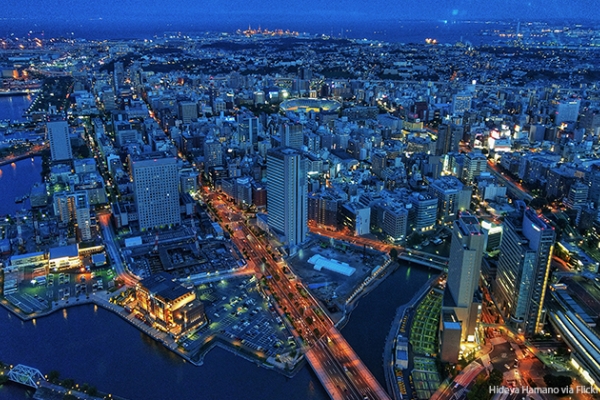A flurry of attention to the varied applications labeled “smart cities”[1] is occurring with growing frequency. Smart cities discussions are turning into smarter cities dialogues among public and private decision-makers, the interested public, researchers, and many others. The result is a re-thinking of the subject. Many observers who once considered the use of advanced technology as the domain of high income places are now looking at its use more broadly (in low and moderate income places) and more “smartly” (adapted to local contexts and stakeholder needs). In particular, knowing that the demographic force of urbanization is and will continue to occur in Africa and Asia when these places are expected to add some two billion more urbanites in the next two decades, these observers—including Rohit Agarwalla, Head of Urban Systems at Sidewalk Labs—are viewing the use of digital technologies as a means to leapfrog the traditional ways of providing public services, doing business, offering better governance, and promoting sustainable urban development.[2] Is this possible?
Several recent publications underline the opportunities and challenges of the new thinking. For example, ESI Thought Lab’s November release of its findings from its global survey assessing smart cities in 136 places revealed that there are many places that qualify: some 27% were in the beginner stage and another 60% still transitioning to maturity. (ESI-Thought Lab based its work on measuring the level of smart city investments, use of data analytics, and application of smart technologies.)[3] A few months earlier, McKinsey Global Institute had issued an extensive report on how 50 cities distributed around the world were successfully using digital solutions to improve the quality of life.[4] Yet MGI, like ESI Thought Lab, point out the inherent difficulties of taking on first-world innovations in third-world cities.
In addition, a year earlier, the OECD warned that while digitalization could improve services and address global/local challenges ranging from the environment to health and from transport to governance, it could also accentuate inequality.[5] According to the World Bank, the lack of broadly available digital infrastructure (terrestrial or fixed and mobile broadband) and the costs of widespread access to the internet are magnifying the digital divide and the slow uptake of smarter cities applications in the developing world. While more than 3.5 billion people have access to the internet, some 60% (or 4 billion) of the world’s population are offline. Of these, 3.3 billion have network coverage (87% of the globe is covered) but for a variety of reasons do not use the internet.[6] Mobile phone ownership is ubiquitous worldwide—there are 5 billion mobile phone users—the majority own smart phones. And while more people in the developing world own mobile phones than have access to clean water and electricity, their smart phone ownership lags, thus slowing down some uptake of smarter cities technologies that depend on internet connections.[7] Despite these gaps, numerous studies are showing that increased digitalization results in improved prosperity in the Global South.[8] Further, other measures demonstrate its contribution to improved quality of life and “happiness.”[9]
So for what purposes and how can the beginner and transitioning cities employ smarter cities technologies? ESI Thought Lab, MGI, and the World Bank agree on key areas for deployment: payment systems (public and private—Nairobi’s M-Pesa system is an example), mobility (e.g. managing congestion, individual service provision—Accra’s Transit app that tracks informal buses called tro-tros is an example), public health (telemedicine, health care payments—M-TIBA, a health wallet in Kenya used for paying licensed medical care is an example), public safety (e.g. crime surveillance—Quito’s bus surveillance system is an example), environment (e.g. mapping that allows for provision of services—Kolkota’s Addressing the Unaddressed app, the slum water vending machines activated by smart cards in Mathere (Nairobi) and Eneza Education testing app for national exams in Ghana, Kenya, Tanzania, and Zimbabwe are examples), and governance (participatory budgeting with on-line voting in Mexico City; anti-corruption through Aadhaar, India’s biometric identity system, used for government payments; and Kenya’s e-Citizen for permits and licenses are examples).
Despite these newly available surveys of innovations adopted in developing world cities, numerous challenges obviously constrain beginner and transitioning cities seeking to engage in smarter cities work. As revealed by ESI Thought Lab and others, intelligent smart city investment programs are dependent on strong fundamentals, are highly contextual, and will yield differing benefits across a variety of applications. They are contextual due to the varying ability of cities to deal with the fundamentals: governance (regulations, cyber security), economy (favorable business climate), infrastructure (from basic electricity to broadband), and talent (user skills).
Additionally, many efficiencies enabled by digital technologies are labor-saving technologies, which means that there will be calls for corresponding efforts to address the loss of income-generating jobs for those displaced. For example, in Bangkok, there are generally two people working on a bus—one driving and one collecting fares. The inefficiency of that system is inherently an income-support mechanism for modest skilled fare collectors. Technological solutions need to be coordinated with social solutions to problems that inevitably will arise in the transition to more efficient economies that can deliver a higher quality of life.
More broadly, the varying efficiency impacts of new technology infrastructures require decision-makers in beginner and transitioning cities to evaluate investments. In determining the best ways to meet infrastructure needs, they may have to decide, for example, on whether to promote smart-phone intensive efforts (networks and device purchase incentives combined with low power area wide networks (LPWAN)) or to engage in fiber optics installations (as being integrated by the Chinese as they craft the Digital Silk Road within their Belt and Road programs).[10] A fiscally stressed city dealing with mobility issues might not be able to afford an intelligent transport system with its sophisticated sensors, processors, timed lighting systems, etc., but it could support a less expensive mobile phone-based app to relieve transportation congestion. Notably, a recent study comparing the economic benefits of the two approaches revealed that while fixed broadband has higher economic benefits in developed countries, mobile broadband is more effective in less developed countries.[11]

Any approach to smarter cities has to be well thought out, but is certainly feasible for beginner and transitioning cities. It depends on developing a digital ecosystem encompassing a collective vision among public sector leaders and stakeholders to determine priorities. (See Figure 1). As the ESI Thought Lab study demonstrates major differences in perception and values exist among public sector, business, and civil society stakeholders, this is no easy task. Further, the growth of smarter cities approaches will require developing a digital ecosystem composed of providers, users, developers, thought leaders, and researchers who work together to remove obstacles, leverage data, deal with cybersecurity, keep up to date with innovations, invest in the appropriate infrastructure, engage in partnerships, and continue steady outlays to maintain and advance their use of technology to deliver cities that are safe, inclusive, resilient, productive, and sustainable.
So, can rapidly urbanizing cities in low- and moderate-income countries become smarter? The answer is a potentially resounding, but for now tentative, yes.
Eugenie Birch is Co-Director of Penn IUR and Lawrence C. Nussdorf Professor of Urban Research and Education at Penn School of Design. Richard Voith is a Penn IUR Fellow, Adjunct Professor of Real Estate at the Wharton School, and President and Principal of Econsult Solutions, Inc. Susan Wachter is Co-Director of Penn IUR and Sussman Professor of Real Estate and Finance at The Wharton School.
[1] The United Nations, after surveying more than 100 definitions of Smart Cities offers this definition: “A smart, sustainable city is an innovative city that uses ICTs and other means to improve the quality of life, efficiency of urban operation and services and competitiveness, while insuring that it meets the needs of present and future generations with respect to economic, social and environmental aspects. Or put more simply: “Smart cities are being redefined as places where different actors employ technology and data to make better decisions and achieve a better quality of life.” Jonathan Woetzel et al, Smart Cities: Digital Solutions for a More Livable Future, McKinsey Global Institute, June 2018, p. 22.
[2] “Interview with Sidewalk Labs urban planner Rohit Aggarwala,” Dazeen, June 6, 2018 https://www.dezeen.com/2018/06/04/alphabet-sidewalk-labs-toronto-future…
[3] Esi-Thought Lab, Smarter Cities 2025, Building a Sustainable Business and Finance Plan, White Paper, Philadelphia, November 11, 2018.
[4] Woetzel et al, Smart Cities: Digital Solutions for a More Livable Future, p.5.
[5] OECD, Key Issues for the Digital Transformation of the G-20, Berlin: January 12, 2017, p.6.
[6] GSMA, Connected Society, State of Mobile Internet, Connectivity 2018, August 2018, p.9
[7] World Bank. 2016. World Development Report 2016: Digital Dividends. Washington, DC: World Bank. doi:10.1596/978-1-4648-0671-1. License: Creative Commons Attribution CC BY 3.0 IGO, p.2; Woetzel et al, Smart Cities: Digital Solutions for a More Livable Future, p.23.
[8] Esi-Thought Lab, Smarter Cities 2025, Building a Sustainable Business and Finance Plan, White Paper, Philadelphia, November 11, 2018.p.6.
[9] Helliwell, J., Layard, R., & Sachs, J. (2018). World Happiness Report 2018, New York: Sustainable Development Solutions Network.
[10] Hong Shen, “Building the Digital Silk Road, Situating the Internet in China’s Belt and Road Initiative,” international Journal of Communication, 12(2018):2683-2701.
[11] Raul Katz and Fernando Callorda, in The Economic Contribution of Broadband, Digitization and ICT Regulation, ITU: Geneva, 2018, pp.31.



